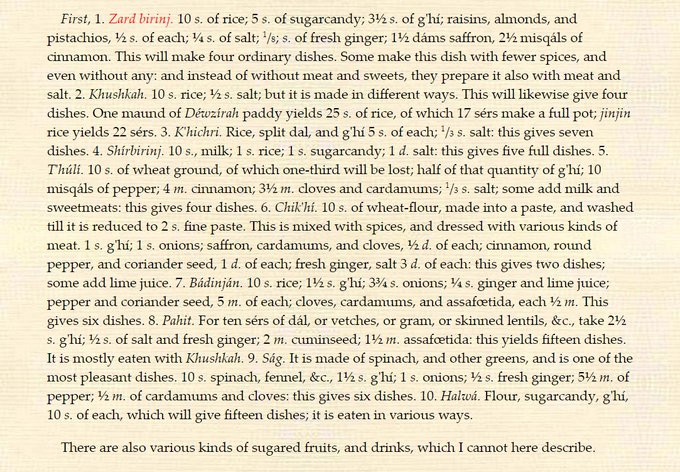|
Just like we have been brainwashed by previous government about many important facts about true Indian history, just like that many people not only in India but all over the world believe that Biryani is from the Mughal culture. Well, it's not the fact and thanks to the people like True Indology who work hard to bring the real information in front of us.
Biryani is made from rice. Rice DOES NOT even grow in original Mughal homeland. The word Biryani is NOT Arabic, Persian or Turkic. It originally comes from a Sanskrit word borrowed by Persian.
The Persian word 'Biryani' is comes from Persian 'Birinj' for rice. Now, this word is NOT FOUND in Old Persian. It suddenly occurs in Middle Persian. According to Mayrhofer's "Etymological Dictionary Of Old Indo Aryan", the word Birinj comes from Sanskrit word vrīhí (व्रीहि).
The word "Biryani" DOES NOT appear until 17th century. It is ABSENT in all the older records. Ain I Akbari (16th century) describes the preparation of a dish known as Zard Birinj (yellow rice) which could be seen as a precursor to Biryani.
Zard Birinj (Yellow rice) was made of rice mixed with spices which were NOT AVAILABLE in Middle East or Central Asia. It was originally vegetarian. But some varieties also added meat to the dish. Clearly, Zard Birinj developed from ancient Indian Haridranna (हरिद्रान्न)
In fact, the word 'Zard Birinj" is a straight translation of "Haridranna" Sanskrit हारिद्र (haridra) means "Yellow". In Persian, Zard (زرد) means "Yellow". "Anna" generally means rice in Sanskrit and "Birinj" is rice in Persian By straight translation, Zard Birinj= Haridranna
The FIRST unambiguous mention of Biryani comes from Nuskha-i-Shahjahani in 17th century. It was made in the kitchens of INDIA which has access to spices. This is NOT surprising. Biryani IS MADE OF rice and spices which could be found only in India (or South East Asia)
Mughals were originally speakers of Chagatai language, which is a Turkic language belonging to Altai family . Which means Altai mountains in West Mongolia is their ultimate origin( Whence they migrated to Central Asia & later India). Rice DOES NOT grow in this Altai region
In the last 10-15 years, they have made attempts to cultivate rice in Mongolia using modern technology. The enterprise has largely not been successful.
At any rate, the FIRST mention of Biryani comes ONLY in 17th century. This was centuries after Mughals entered India. This straightly disproves the claim that "Mughals brought Biryani to India" The best quality of Biryani is made from Basmati rice, which is grown ONLY in the Indian subcontinent. Not Arabia or Mongolia Now I examine the claim that "Mughals brought Biryani to India" with textual sources. In this respect, data from Baburnama is extremely valuable as a contemporary Mughal source for geographical and botanical data To begin with, What was India ('Hindustan') during those days? In Baburnama, Hindustan begins from the East of Kabul. When Mughal emperor Babur reached Lamghan (Laghman), Ningnahar (Nangarhar) and Adinapur (Jalalabad) which are towns to east of Kabul in today's Northeast Afghanistan Babur declared that he reached the border of Hindustan.
Other grounds, other trees, other animals, other manners & customs" is how Babur describes difference between Hindustan and Central Asia The North/West of Kabul was known as "Khurasan" & wasn't part of Hindustan. Kabul & Qandahar were entrepots between Hindustan and Khurasan.
Throughout Baburnama, Babur DOES NOT mention rice when he was in Central Asia. He mentions other crops and cereals but rice is completely ABSENT. What to say of Biryani? The FIRST mention of rice farming in Baburnama occurs AFTER Babur enters Hindustan. He mentions that good crops of rice and corn were cultivated in Nangarhar, a place which Babur describes as "borderland of Hindustan" Next, we are told that Rice was grown on "steep terraces" in the Nur valley of Laghman (today's Northeast Afghanistan) in the Hindukush mountains, which was again considered a part of Hindustan Today, these regions are Afghan Pak borderlands. Then, the Mughal army conducted a night raid and looted rice fields of "Mil Kafirs". These were the Nuristani and Chitrali Kalash Kafirs of Hindukush mountains. They put up a brave resistance and fought the Mughal army.
To conclude, Mughals DID NOT bring Biryani to India. Far from it. They did not even have natively cultivated rice. Rice could not be grown in their homelands in those days. They first encountered rice fields in Hindustan and looted those rice fields during night raids.
o all the dunderheads talking potatoes, tomatoes and Chilles. There were NO potatoes, tomatoes and Chilles in the Mughalai Biryani of Shah Jahan and Aurangzeb. There is no mention of these ingredients in Nuskha I Shahjahani Biryani |
Like us on Facebook if You haven't already
More ways to connect
Archives
July 2023
Loading...
|













 RSS Feed
RSS Feed